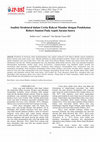Papers by Sherally Munshi
International Journal of Law in Context, Jan 7, 2024

Ethnic Studies Review
As United States v. Bhagat Singh Thind becomes an important site of collective memory and identit... more As United States v. Bhagat Singh Thind becomes an important site of collective memory and identity formation, the hundred-year anniversary of the decision presents itself as an occasion for critical reflection about how we make sense of this particular past, our identification within it, and its relevance to our contemporary moment. Thind has been read primarily as a case about the racial identification of Indians in the United States and their racialized exclusion from citizenship. This essay explores some of the limits of that framing, arguing that it tends to reify legal constructions of racial difference while obscuring the imperial dimensions of the case, namely Thind’s involvement with the transnational anticolonial Ghadar movement. Moreover, to remember the case as primarily one about racial injury consigns us to liberal frameworks of rights and recognition and to recapitulating nationalist narratives of racialized exclusion and earned inclusion, leaving unexamined the role t...
Routledge eBooks, Feb 8, 2023
Social Science Research Network, 2016
5. While the Komagata Maru affair, among other campaigns against "Hindus" across the Pacific Nort... more 5. While the Komagata Maru affair, among other campaigns against "Hindus" across the Pacific Northwest, largely receded from public memory in the United States, Canadian Sikhs have long demanded a formal apology from the Canadian government. In April of 2016, Prime Minister Justin Trudeau announced that he would make a formal apology in the House of Commons. See Adrija Roychowdhury, Simply Put: In Canada's Justin Trudeau apology for Komagata Maru, an attempt to heal a century-old scar, THE INDIAN EXPRESS (April 14, 2016), available at http://indianexpress.com/article/explained/justin-trudeau-komagata-maru-in-the-apology-forkomagata-maru-an-attempt-to-heal-a-century-old-scar/.
Law's Infamy
Sherally Munshi highlights some unacknowledged infamous cases while challenging constitutional th... more Sherally Munshi highlights some unacknowledged infamous cases while challenging constitutional theorist Jack Balkin’s claim that the Supreme Court consistently redeems itself. She seeks to do so by identifying infamous cases as the touchstone against which constitutional progress can and should be measured. Munshi contends that this narrative ignores a series of cases starting in 1832 with Johnson v. M’Intosh and extending through 2018 with Trump v. Hawaii.

Social Science Research Network, 2015
How does the appearance of racial difference shape our view of citizenship and national identity?... more How does the appearance of racial difference shape our view of citizenship and national identity? This Article seeks to answer that question by examining to early twentieth-century cases involving the naturalization of Indian immigrants in the United States. In United States v. Bhagat Singh Thind (1923), the Supreme Court determined that ‘Hindus’ were ineligible for citizenship in the United States because they were not ‘white persons.’ The Court recognized that, although individual immigrants from India had proven themselves capable of cultural assimilation, as a group, they were disqualified because they would remain visually inassimilable. Through a close reading of the Court’s analysis, this Article examines the ways in which law participates in the visual construction of both racial difference and national identity. Dinshah P. Ghadiali was one of several Indian immigrants whom the United States sought to denaturalize in the wake of Thind. Since the Court announced that visual assimilability was the relevant test for naturalization, in 1932, Ghadiali found himself in the peculiar position of having to defend his citizenship by demonstrating to a judge that he looked white. At his denaturalization trial, Ghadiali submitted into evidence several photographs of himself, his children, and his properties, assuring the judge, “You will see my family became so American.” Through a close reading of these photographs, I explore the demands of visual conformity that the law imposes on racialized minorities. This Article also seeks to introduce to comparative legal scholarship a method of analysis that engages the critical reflections of minoritized subjects to challenge the received authority of legal texts. While comparative legal scholarship seeks to defamiliarize the legal rules, institutions, and culture of one country by comparing them to those of another, the “minor comparativism” proposed in this article seeks to challenge the country’s self-image by engaging the perspective and reflections of its subordinated minorities.

Social Science Research Network, Nov 1, 2020
When scholars and lawmakers ask who should be allowed to cross borders, under what circumstances,... more When scholars and lawmakers ask who should be allowed to cross borders, under what circumstances, on what ground, they often leave unexamined the historical formation of the border itself. National borders are taken for granted as the backdrop against which normative debates unfold. This Article intervenes in contemporary debates about border crossing by bringing the border itself into the frame of normative consideration. It does so by exploring the colonial dimensions of the national border and calling attention to the ways in which national borders circumscribe and constrain the political imaginary. Focusing on the United States in particular, this Article seeks to defamiliarize the southern border by resituating it within a widened context of settler colonialism and hemispheric domination. Rather than offer a normative case for building a wall or opening borders, this Article asserts that meaningful engagement with the border question requires that we unsettle the border by critically examining the colonial processes and epistemic formations that naturalize and legitimate it.

SSRN Electronic Journal, 2021
Penelitian ini bertujuan untuk mendeskripsikan jenis analisis struktural Cerita Rakyat Mandar den... more Penelitian ini bertujuan untuk mendeskripsikan jenis analisis struktural Cerita Rakyat Mandar dengan pendekatan Robert Stanton pada aspek sarana sastra. Metode penelitian ini adalah deskriptif kualitatif. Sumber data dalam penelitian ini adalah kumpulan cerita dari Lomba Karya Tulis Opy untuk Cerita Rakyat Mandar. Sumber data lainnya berasal dari jurnal, dokumentasi dan lain-lain. Teknik pengumpulan data yang digunakan adalah teknik mencatat. Data yang terkumpul kemudian dideskripsikan berdasarkan struktur aspek sarana kesusastraan. Langkah-langkah yang dilakukan adalah memilih dan menentukan objek penelitian, mengidentifikasi, membatasi materi pelajaran, mengumpulkan data, menganalisis data, dan menemukan kesimpulan. Hasil penelitian menunjukkan bahwa dalam judulnya, masyarakat meyakini bahwa siapapun yang melewati jalan jika tidak meninggalkan batu kecil dianggap mengundang hal-hal buruk atau musibah dalam hidup. Sudut pandang yang digunakan terbatas pada orang ketiga, yaitu karakter dia. Gaya bahasanya adalah fiksi, sedangkan nada yang ditunjukkan oleh pengarang dalam cerita rakyat bersifat misterius. Naong Batu di Tande merupakan simbol dalam Cerita Rakyat Mandar dan menunjukkan ironi yang dramatis.

PSN: Politics of Race (Topic), 2016
Racism in the United States has proven to be a remarkably recombinant ideology, ever shifting in ... more Racism in the United States has proven to be a remarkably recombinant ideology, ever shifting in its dominant practices and expressions, but invariably reproducing distinctions among people as justifications for preserving social distance. This article, through a recovery of the history of “Hindu” exclusion from the United States in the early twentieth century, traces the emergence of what some scholars have identified as the “neo-racism” of our contemporary global order, a “racism without races” that disappears into the naturalized horizon of national boundaries. Almost as soon as Indians began immigrating to the United States, exclusionists hoped to pass a Hindu Exclusion Act modeled after the Chinese Exclusion Acts. Though their efforts failed, in 1917, another law, barring immigration from an invented “Asiatic Barred Zone,” was passed by Congress with an overwhelming majority. The ingenuity of that law was that it restricted immigration not on the basis of identity — racial or n...

Yale journal of law and the humanities, 2015
Contemporary immigration law cannot be understood without an understanding of the imperial contex... more Contemporary immigration law cannot be understood without an understanding of the imperial contexts from which they emerged. This Article explores the continuity between the imperial formations that defined the nineteenth century and the practices of immigrant exclusion that emerged in the early twentieth century, by focusing on Indian immigration to — and eventual exclusion from — the United States and other white-settler nations. Until the turn of the twentieth century, there were relatively few restrictions on international migration. European imperialism and settler colonialism were sustained by mass migration, both voluntary and involuntary. With the arrival of Asian immigrants, white-settler nations abandoned their longstanding commitment to “the rights of man to change his home and allegiance” to establish an “absolute and unqualified” right of nations to exclude and deport foreigners. As this Article demonstrates, the legislative and political maneuvers that culminated in th...

In 1932, the United States government sought to cancel the citizenship of Dinshah Ghadiali, an im... more In 1932, the United States government sought to cancel the citizenship of Dinshah Ghadiali, an immigrant from India, alleging that Ghadiali “by reason of his not being a free white person or a person of African nativity or descent is, and was, ineligible racially for naturalization.” Ghadiali was one of dozens of Indian immigrants targeted for denaturalization in the wake of United States v. Thind (1923), in which the Supreme Court declared that “Hindus,” though capable of cultural assimilation, would remain visually unassimilable. At his denaturalization trial, Ghadiali submitted into evidence a series of photographs, assuring the judge, “You will see my family became so American.” How do these photographs purport to show that Ghadiali and his family had become “so American”? In this essay, through a through a close reading of Ghadiali’s photography, I explore a tension between the visualization of race—a practice at once institutionalized by law and inextricably bound with the med...

Recognizing human freedom is never as simple as acts of legal pronouncement might suggest. Libera... more Recognizing human freedom is never as simple as acts of legal pronouncement might suggest. Liberal abstractions like freedom and equality; legal formulations of personhood, free will, and contract; the constructed divisions between public and private, self and other, home and market on which the former are predicated — these are often inadequate to understanding, let alone realizing, the shared aspirations they supposedly define. By the same token, the dense and dynamic relations of power that characterize any liberal society overwhelm and exceed our critical vocabulary. “Racism,” “sexism,” and “capitalism” powerfully name structures of inequality, but they fail to capture the full spectrum of social relations, practices, and exchanges that reproduce inequality — deep structures of feeling, unspoken common sense, the stories we tell ourselves about the world and our places in it. Focusing on an early twentieth-century case involving an immigrant convicted of “white slavery,” accused...

In legal scholarship on immigration, as in public discourse, we often take for granted the normat... more In legal scholarship on immigration, as in public discourse, we often take for granted the normative and conceptual priority of nation state borders—as though borders were here first, and migrants came second. But people have been migrating since long before the establishment of nation state borders. European imperialism was sustained by mass migration. The British imperial system consisted of the voluntary migration of settlers and administrators as well as the involuntary or forced migration of enslaved Africans, Asian “coolies,” and criminal convicts. U.S. settler imperialism continues to effect mass displacements. Because the conventional nation-state framing of immigration law often obscures the imperial histories that have shaped the inequalities that now compel migration, this chapter asserts that scholars of immigration law and history have much to gain by displacing the nation-state framework, through which questions about immigration law and policy are raised, and replacin...
The American Journal of Comparative Law
The American Journal of Comparative Law
American Journal of Comparative Law, 2015











Uploads
Papers by Sherally Munshi